Accidental Bites and Poor Handling in K-9 Training
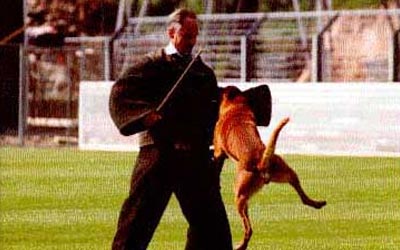
If you would like to learn more about handling dogs in bite work, refer to our videos titled:
I put myself through college teaching skydiving and bartending; at the time it was a real ego trip. My friends and I were known as "those crazy fools who drink all night and jump out of airplanes every Saturday and Sunday." It was a great way to meet women. We lived for the reputation until one Saturday when Bob Jessas' chute didn't open; he panicked and didn't pull his reserve chute. He was a Vietnam vet with two bronze stars, he wasn't supposed to panic. His death changed us all, and from that point on, we took a different attitude about our sport.
The first time you witness a serious accidental bite, you will change your attitude about your training sessions with your Police Dogs.
There are only three reasons for an accidental bite:
- Equipment failure
- Helper error
- Poor handling
I will address poor handling in this article and discuss helper errors in future articles.
Good handling becomes a very important concern when you start to train body bites. The risks to your helper are increased tenfold.
Good handling is as much of an art as doing good helper work. The sad thing is that most trainers don't give it enough thought until they see how much damage can be done in that split second when something goes wrong.
To begin with, the handler and helper must have excellent communication. This should go as far as having prearranged hand signals for reattacks and standstills, outs, and REAL BITES. (How many have that one?)
But before this, the handler must learn proper leash handling during body bites and the proper procedure for off-leash pick-ups, while the dog is still on the helper.
The first thing every handler must learn during bite work is to plant his feet and NOT MOVE unless the helper knows he is going to. The helper must know where the end of the leash is and where his safety zone begins. If the handler lets his dog pull him toward the helper, the communication is lost and we have a potentially dangerous situation. We see this too often with new handlers.
It's not a bad idea to put every new trainer in a suit and make him walk the circle around a very tough dog. Being new to the sport, they will quickly begin to pray the handler doesn't move and let the dog bite them.
With Body Bites, the next step the handler must learn is to hold the leash so that he can control his dog. This means two hands on the leash: one near the collar and one on the end of the line.
When working close to the helper, the handler locks the elbow on the hand near the collar and holds the dog down. This prevents the dog from bouncing high and into the helper's face. With this control, the handler can work with the helper and target the dog to the part of the body they wish.
When doing on-leash bite work and taking your dog off the helper at the end of the bite, always grab the line very close to the collar before the dog releases the bite. You will then have control so the helper can step away from the dog and not worry about an afterbite.
Accidental bites happen when the dog is biting the upper body and the handler calls him off while only holding the end of the leash. If there is slack in the line, the dog can take a leg bite or worse, a hand bite.
The next area of real importance is proper procedure in picking the dog up after off-leash bite work. This is done one way when the helper is standing and another way when the helper is on the ground.
With the helper standing, and the dog still on a bite, I like to approach so the dog can see me. I give encouragement and tell him he is doing a good job.
This does two things: it gives him confidence and puts his mind back on the helper. I take the leash short (by the collar) and move behind the dog, constantly giving praise and repeating the bite command (Good Packen, Good Packen). I want him to feel comfortable with me being close to his work. If my talking distracts him, I will be quiet and just pat his side.
When you take him off the bite, you still have him short with no slack in the line and the helper can then step away from the dog.
You never call the dog off when the helper is between you and the dog. You have lost your control at that point.
The last area I will discuss is off-leash pickups with the helper on the ground. The job of the HANDLER, in this case, is to protect the helper's face before he takes the dog off.
The problem is this: when the HANDLER approaches from the rear, most dogs will climb up on top of the helper because they don't want to be taken off. This action pushes the dog into the helper's face.
The solution is for the HANDLER to go around the helper and approach the dog from the front.
The HANDLER kneels down, on top of the helper placing his leg between the head of the dog and the face of the helper. He takes his dog very short at the collar and makes sure he has control of the dog before it comes off.
An accidental bite here could be very serious.
Now let's have a Quick Review of safe Handler procedures for body bite work:
- Step 1 - Plant your feet and don't let the dog pull you to the helper.
- Step 2 - Always use 2 hands on the leash: one at the end and the other close to the dog. Hold the dog down to prevent him from going into the helper's face.
- Step 3 - When taking the dog off the helper, always grab the dog short to prevent afterbites.
- Step 4 - In off-leash work with the helper standing, approach so the dog can see you. Make him feel comfortable and don't take him off the helper until after you have control.
- Step 5 - On off-leash bites with the helper on the ground, approach from the front and put yourself between the helper's face and the dog. Make sure the dog is secure before taking him off the helper.
This new interest we are seeing all across America in Police K-9s is going to increase accidental bites in training. Proper handling will reduce your odds of having one.




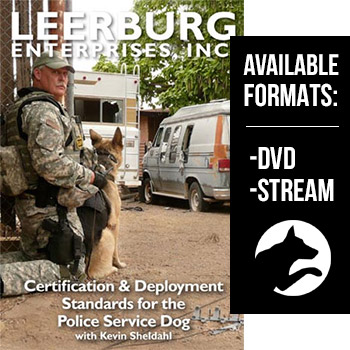
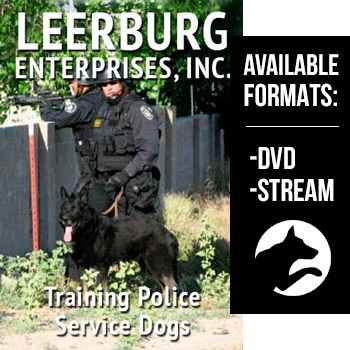
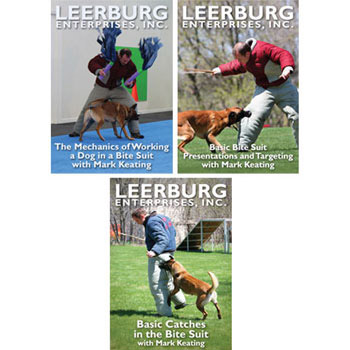
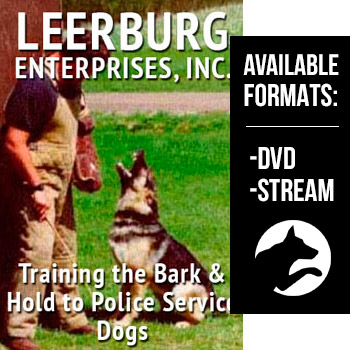
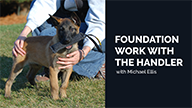
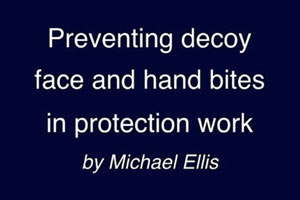
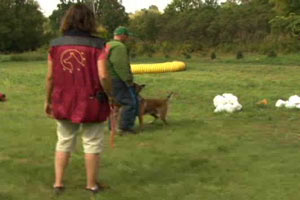
Ask Cindy.